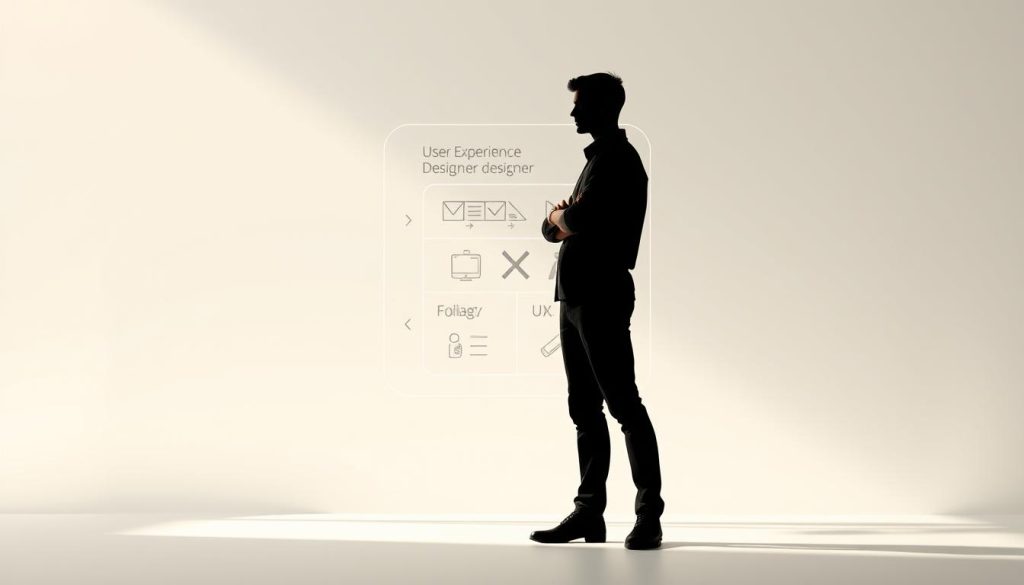In the 1990s, Donald Norman worked as an Apple Fellow and created the term « user experience. » He defined it as how people respond to using products, systems, or services. This concept changed how companies think about their offerings.
The idea goes beyond simple usability. It covers both functional performance and emotional impact. Every touchpoint matters in creating a complete experience.
This field combines multiple disciplines. Design, psychology, engineering, and business principles all play important roles. The approach applies to websites, apps, physical products, and service interactions.
Organizations now recognize the strategic value of excellent user experience. It directly affects customer satisfaction and business success. This guide provides practical methods to achieve better results.
Table of Contents
Key Takeaways
- Donald Norman pioneered the UX field while working at Apple in the 1990s
- User experience encompasses both functional and emotional aspects
- The practice involves multiple disciplines including design and psychology
- UX applies to digital interfaces, physical products, and service experiences
- Excellent user experience directly impacts customer satisfaction and retention
- Organizations can implement proven techniques to improve their offerings
- The field has evolved from niche specialty to mainstream business priority
Setting the Stage: The Importance of a Seamless Digital Experience
The quality of digital interactions now serves as a primary differentiator for brands. Customers expect effortless journeys across websites, apps, and services. Meeting these expectations requires thoughtful planning.
Defining User Experience and Its Impact
This concept encompasses every aspect of human-computer interaction. It includes visual appeal, functional performance, and emotional response. The collective impression shapes customer perceptions.
Well-executed design creates positive engagement and builds trust. Poor implementation leads to frustration and abandonment. The impact extends beyond immediate interactions.
The Business Benefits of Excellent UX
Organizations investing in quality design see measurable returns. Customer retention improves while support costs decrease. Conversion rates often increase significantly.
Thoughtful interface design creates competitive advantages. It turns casual visitors into loyal advocates. The business impact becomes evident through key metrics.
| Experience Quality | Customer Retention | Conversion Rate | Support Costs |
|---|---|---|---|
| Excellent Design | 75-85% | 8-12% | Low |
| Average Implementation | 55-65% | 3-5% | Medium |
| Poor Execution | 25-35% | 1-2% | High |
Every digital touchpoint contributes to overall perception. A company’s website often serves as the first impression. Quality service delivery reinforces positive experiences.
Deep Dive into User Experience (UX) Strategies
Contemporary design thinking extends far beyond basic functionality to encompass emotional connections. This evolution reflects how the field has matured from Donald Norman’s original concept.

Evolution and Conceptual Foundations
The practice has grown into a multidisciplinary approach drawing from psychology, engineering, and business strategy. Unlike usability which focuses on efficiency, user experience considers the complete journey.
Jesse James Garrett’s five-plane model provides a systematic framework for comprehensive design. It moves from strategy to visual execution through scope, structure, and skeleton phases.
Other influential models help map the territory of effective digital creation. Peter Morville’s honeycomb identifies seven essential facets for quality results.
| Framework | Key Components | Primary Focus |
|---|---|---|
| Garrett’s Five Planes | Strategy, Scope, Structure, Skeleton, Surface | Systematic design process |
| Morville’s Honeycomb | Useful, Usable, Desirable, Findable, Accessible, Credible, Valuable | Quality dimensions |
| CUBI Model | Content, User Goals, Business Goals, Interaction | Alignment of elements |
Integrating Emotional and Functional Aspects
Both practical and emotional aspects are inseparable for successful outcomes. Functional excellence without emotional satisfaction creates hollow engagements.
Emotional appeal without usability leads to frustration and abandonment. Effective strategy balances task completion with aesthetic pleasure and trust-building.
The complete temporal arc includes anticipation before use and reflection afterward. This holistic approach ensures meaningful connections throughout the journey.
User Research and Design Thinking: The Backbone of Effective UX
The foundation of any successful digital product lies in understanding human behavior before writing a single line of code. This discovery process forms the essential first step in quality creation.
Gathering Insights Through Interviews and Testing
Multiple investigation methods reveal different aspects of audience needs. Direct conversations uncover motivations that surveys might miss.
Usability testing identifies interaction friction points. Behavioral analytics show how people actually use systems rather than how they say they use them.
| Research Method | Primary Insight Gained | Best For |
|---|---|---|
| User Interviews | Motivations and pain points | Qualitative depth |
| Usability Testing | Interaction obstacles | Identifying friction |
| Behavioral Analytics | Actual usage patterns | Quantitative data |
Applying Design Thinking to Solve User Problems
Design thinking provides a structured approach to problem-solving. It begins with empathy and moves through iterative cycles.
This methodology complements traditional research by framing challenges from human perspectives. Teams prototype rapidly and test assumptions continuously.
The process ensures solutions address real needs rather than assumed requirements. It transforms raw information into actionable design decisions.
Mastering Information Architecture and Navigation for Better UX
A well-organized website acts like a clear roadmap. It guides visitors effortlessly to their destination. This structural foundation is called information architecture.
It focuses on organizing content so people can find what they need without confusion. Good structure makes every interaction smooth and efficient.

Structuring Content Intuitively
Effective content organization starts with understanding how your audience thinks. Techniques like card sorting reveal how people naturally group information.
This insight helps create logical categories and clear labels. A predictable hierarchy reduces cognitive load.
Visitors should never feel lost. Clear pathways on all site pages help them complete tasks quickly.
Enhancing Navigation for Increased Engagement
Simplified navigation is crucial for keeping people engaged. A clear menu system acts as a constant guide.
Effective navigation directly impacts key business metrics. It can significantly reduce cart abandonment and increase content discovery.
Implementing a friendly navigation system encourages exploration. It turns casual browsers into committed customers.
| Navigation Type | Ease of Use | Impact on Engagement | Best For |
|---|---|---|---|
| Horizontal Menu Bar | High | Directs users to main sections quickly | Sites with limited top-level categories |
| Mega Menu | Medium | Shows extensive content at a glance | Large e-commerce or content-rich sites |
| Hamburger Menu | Low (on desktop) | Conserves screen space | Mobile-first designs or minimalist sites |
Testing your site architecture with real people is essential. It validates that your organization makes sense to them, not just to your internal team.
This proactive approach ensures your information architecture supports both findability and a positive overall impression.
Creating Visually Engaging and Emotionally Resonant Interfaces
Visual appeal in digital products goes beyond simple decoration to become a fundamental communication tool. The right aesthetic choices establish credibility and guide attention effectively.
The Role of Visual Design and Aesthetics
Strong visual design communicates brand values through deliberate choices. Color palettes, typography, and spacing work together harmoniously.
Good aesthetics reduce cognitive strain and create positive first impressions. They show care and professionalism throughout the interaction.
Beautiful interfaces build trust and make interactions more enjoyable. They work synergistically with functional clarity rather than opposing it.
Wireframing, Prototyping, and Iterative Testing
Wireframing begins the transformation from concept to tangible interface. Low-fidelity sketches explore structure and content flow efficiently.
Prototyping advances the design process through increasing fidelity levels. Each iteration refines both visual elements and interaction patterns.
Iterative testing validates design decisions with real feedback. This approach ensures the final product balances aesthetic appeal with practical usability.
UX vs. UI: Clarifying Roles, Goals, and Impact
While often used interchangeably, user interface and user experience represent distinct yet interconnected disciplines. Many professionals transition between these roles as their skills develop.

User interface design concentrates on the visual and interactive elements people directly engage with. This includes buttons, forms, menus, and typography that create the digital surface.
Key Differences Between Usability and Visual Appeal
Interface specialists focus on pixel-perfect precision and aesthetic consistency. They ensure each visual element communicates clearly and functions smoothly.
Experience design takes a broader view of the complete journey. It considers emotional responses across all touchpoints and channels.
Both disciplines contribute complementary value to successful products. Beautiful interfaces that don’t support goals create frustration. Well-structured experiences with poor visual presentation fail to engage.
Understanding these distinctions helps organizations structure teams effectively. It ensures both strategic experience planning and detailed interface execution receive appropriate attention.
Implementing Responsive Design Across Digital Platforms
Modern digital consumption spans countless devices, demanding flexible design approaches. A successful web presence must deliver consistent quality whether accessed on smartphones, tablets, or large monitors. This adaptability forms the core of responsive implementation.
Optimizing for Mobile and Desktop Experiences
Mobile optimization requires specific considerations for smaller screens. Touch-friendly interface elements and simplified navigation patterns improve usability. Content prioritization becomes crucial with limited screen space.
Desktop experiences benefit from more complex layouts and detailed interactions. Both versions should maintain identical core functionality and brand identity. The design must feel native to each device type.
Performance optimization is particularly important for mobile users. Faster page load times and efficient data delivery over cellular networks enhance accessibility. Tools like Google PageSpeed Insights provide valuable metrics for improvement.
Testing across real devices under various network conditions ensures reliable performance. This practical validation surpasses desktop simulation alone. It guarantees your site works effectively in actual usage contexts.
Real-World Case Studies and Success Stories
Concrete examples from leading companies demonstrate how thoughtful design directly impacts business success. These real-world applications show measurable improvements in customer retention and revenue growth.

Analyzing Effective UX Implementations
Major e-commerce platforms have reduced cart abandonment by 30% through simplified checkout processes. Their research identified friction points that caused customer frustration.
Streamlined navigation and clearer calls-to-action created smoother purchasing journeys. These solutions addressed specific pain points that analytics revealed.
Financial institutions improved their mobile banking applications with better information architecture. Customer support calls decreased by 25% as users found answers more easily.
Lessons from Industry Leaders
Successful organizations share common approaches to digital excellence. They prioritize continuous testing and iteration based on user feedback.
Companies known for outstanding web experiences invest in understanding customer needs before developing solutions. This proactive approach prevents costly redesigns later.
Even industry leaders learn from mistakes through rigorous UX improvement processes. The key differentiator is commitment to ongoing refinement.
These case studies prove that effective design doesn’t require massive budgets. It demands disciplined focus on solving real user problems through thoughtful solutions.
Addressing Common Challenges and Continuous UX Improvement
Even the most thoughtfully planned digital products encounter challenges during implementation. Teams often face resource constraints and technical limitations that impact the final outcome. Recognizing these obstacles is the first step toward effective problem-solving.
Troubleshooting Usability and Navigation Issues
Common usability problems include confusing menu structures and unclear calls-to-action. These issues create friction points that hinder smooth interactions. Systematic diagnosis through analytics review helps identify specific pain points.
Heuristic evaluation provides a framework for spotting accessibility barriers. Targeted testing reveals how real people struggle with navigation. This approach leads to practical solutions that enhance overall usability.
Embracing Iterative Feedback Loops
Successful design improvement relies on continuous feedback collection. Organizations should establish multiple channels for gathering input. Customer support interactions and in-app mechanisms offer valuable insights.
This ongoing process ensures digital services evolve with changing needs. Prioritizing improvements based on impact maximizes resource allocation. The cycle of testing and refinement creates sustainable competitive advantages.
Viewing design as an ongoing practice rather than a one-time project yields better results. Each iteration brings the product closer to ideal solutions. Continuous support for this approach maintains alignment with user expectations.
Conclusion
The journey toward exceptional digital creation begins with recognizing that human-centered design is an evolving practice. While methodologies provide structure, successful implementation requires balancing functional needs with emotional resonance.
Emerging technologies like AI and VR continue to reshape interaction possibilities. These advancements demand adaptable approaches that maintain core principles while embracing innovation.
True excellence emerges through continuous refinement rather than one-time projects. Organizations must commit to understanding audience needs and iterating based on real feedback.
The most impactful design solutions create facile utiliser experiences that feel intuitive. They demonstrate respect for people’s time while delivering genuine value through every interaction.
As the field expands, maintaining focus on human needs remains essential. This commitment ensures digital services continue to improve lives meaningfully.
FAQ
What is the main goal of design thinking in a project?
The primary objective is to solve problems creatively by focusing on people’s needs. This process involves empathy, prototyping, and testing to develop solutions that are both functional and meaningful for the end-user.
How does information architecture affect a website?
A well-structured architecture organizes content logically, making it easy to find. This improves navigation, reduces frustration, and helps visitors complete their desired actions efficiently.
Why is iterative testing important for a digital service?
Continuous testing with real people uncovers issues early, allowing for refinements before launch. This approach saves time and resources while ensuring the final product meets high standards of satisfaction.
What distinguishes a good interface from a great one?
A great interface combines visual appeal with effortless interaction. It guides users intuitively, supports their goals without confusion, and creates a positive emotional connection with the application or site.
Can you explain the role of wireframing in the design process?
Wireframing acts as a blueprint for a page’s layout. It focuses on structure and placement of elements without visual distractions, ensuring the flow and functionality are solid before visual design begins.





